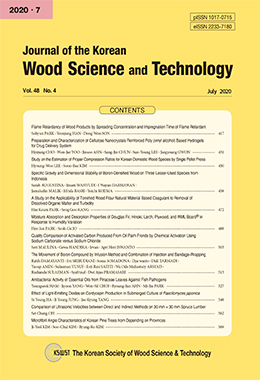4종의 판상형 목재제품의 방염제 도포량과 침지시간에 따른 방염성능을 분석하기 위하여 소방청의 방염성능기준에 따라 목재제품의 탄화길이와 탄화면적을 측정하였다. 잣나무 합판, 낙엽송 합판, 편백 판재, 타공처리된 자작나무 합판에 자체개발된 방염제를 각각 300, 500 g/m2씩 도포하고 방염처리되지 않은 시험편과 비교하였다. 일반적으로 방염제의 도포량이 증가함에 따라 탄화길이와 탄화면적이 감소하여 방염성능이 증가하는 경향을 나타냈으나, 낙엽송 합판을 제외하고 탄화길이와 탄화면적의 감소량이 크지 않았다. 타공처리된 자작나무 합판의 침지시간에 따른 방염성능은 60분의 침지시간까지 양의 상관관계를 나타냈으나, 그 이후 점차 완만해지는 경향을 보였다. 방염제의 도포량과 침지시간에 따른 목재제품의 방염성능은 추후 방염성능 기준에 맞는 불연·준불연 목재의 생산을 위한 기초자료로 이용될 것으로 기대된다.
The flame retardancy, such as carbonized length and area, of four plank type wood products by the spreading concentration and impregnation time of flame retardant were measured according to standard of the Nation Fire Agency in Republic of Korea. To measure the flame retardancy, Korean pine plywood, Japanese larch plywood, Japanese cypress planks, and perforated birch plywood boards were treated with self-development flame retardant by 300 and 500 g/m2 spreading concentration and those were compared with control specimen. In general, the flame retardant performance of wood products improved as the spreading concentration of flame retardant increased. Except for Japanese larch plywood, there was no significant difference in the flame retardant performance by the spreading concentration. The flame retardant performance of perforated birch plywood board was positively correlated up to 60 minutes of impregnation time, but then gradually decreased. These results about the flame retardancy of wood products by spreading concentration and impregnation time were expected to be basic data for improving flame-retardant treated wood.


